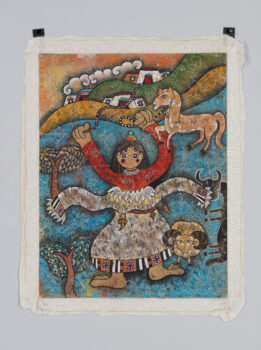Lhasa, Tibet
2006


Lhasa, Tibet
2006


Dedron’s paintings focus on the beauty of nature and the changing traditional Tibetan life and environment. She often depicts women and animals and uses warm, natural color palette with tones of Tibetan butter milk tea and cooler colors of sacred mani stones in the medium of mineral pigments on Tibetan paper or canvas. She does not employ any symbolic language of Tibetan Buddhist iconography but reveals her humanistic and environmental attitudes and worries about Tibetan culture.In this painting, a girl wearing a customary sheepskin garment raises her arms to herd sheep and yak, while a Tibetan antelope, an endangered species, runs at some distance. Further, behind rolling hills are traditional houses, and stylized clouds that may bring rain. The high horizon references the vastness of the Tibetan landscape. The unusually colored sky is its integral part and may imply dusk. Across the entire expanse of the painting various graffiti-like dotted images invoke rock carvings found throughout the land, some are not ancient but contemporary, which collectively represent traces of life in this wondrous environment.Notably, the girl has no nose nor mouth but prominent eyes. Dedron worked at an orphanage where she was introducing blind children to color through touch. The experience led her to emphasize her characters’ eyes, the distinctive element in her paintings.
In Buddhism gender is considered more fluid compared to some other religions. Certain traditions emphasize the importance of all genders in achieving enlightenment. The feminine is considered an embodiment of wisdom and the masculine is an embodiment of method.
While the primary religious goal for followers of Buddhism is enlightenment, many of the practices also serve secular goals related to daily life, including ethical conduct and cultivating well-being.
A vehicle for the preservation and transmission of knowledge. The Buddha’s teachings were originally passed down through oral transmission and storytelling, and stories of the Buddha’s past lives are considered an important source of inspiration and guidance.
Today, Tibetans primarily inhabit the Tibetan Plateau, situated between the Himalayan mountain range and the Indian subcontinent to the west, Chinese cultural regions to the east, and Mongolian cultural regions to the northeast. During the 7th to 9th century, Tibetan rulers expanded their empire across Central Asia, and established Buddhism as the state religion.
Get the latest news and stories from the Rubin, plus occasional information on how to support our work.